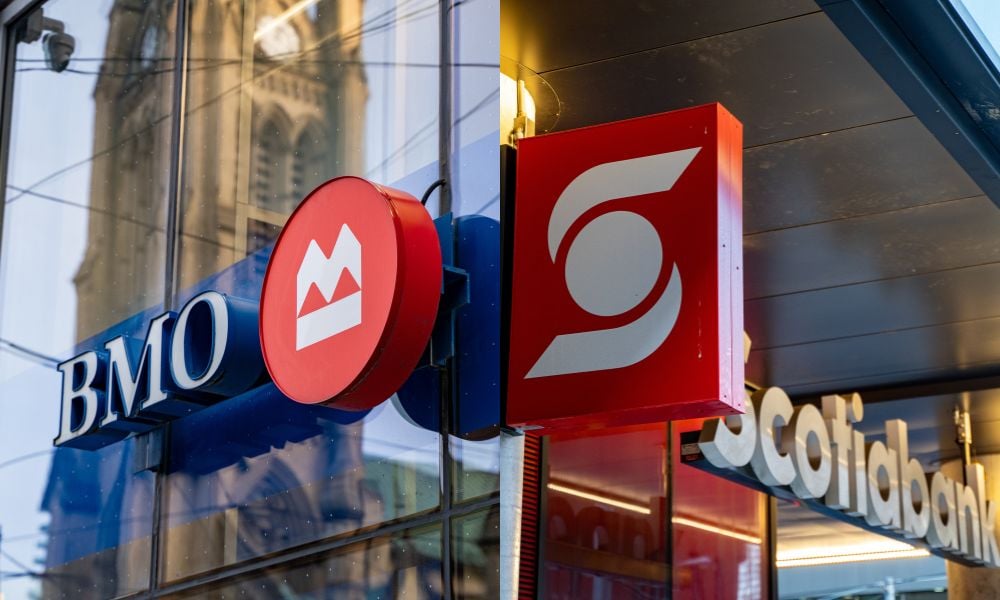Banking giants release first-quarter financial results amid gathering economic storm clouds

Two of Canada's biggest banks, Bank of Montreal (BMO) and Scotiabank, just released their financial results for the first quarter of 2025.
BMO posted solid growth for the first quarter ended January 31, 2025, reporting net income of $2.14 billion, up from $1.29 billion in the same period last year.
Adjusted net income climbed to $2.29 billion, up from $1.89 billion a year earlier. Earnings per share (EPS) increased to $2.83 from $1.73, while adjusted EPS rose to $3.04 from $2.56.
BMO’s Canadian personal and commercial banking division posted a net income of $894 million, reflecting a 3% decline due to higher expenses and an increase in provisions for credit losses. On the other hand, the US personal and commercial banking arm saw a 4% increase in reported net income, reaching $580 million.
BMO’s total provisions for credit losses rose to $1.01 billion, up from $627 million a year earlier, driven by higher provisions for commercial banking and Canadian consumer lending. Despite this, the bank maintained a strong Common Equity Tier 1 (CET1) ratio of 13.6%.
"We delivered strong first quarter performance with broad-based revenue growth driving positive operating leverage in each of our operating groups," CEO Darryl White said in a media release. “Provisions for credit losses declined from the prior quarter as expected, and we initiated our share buyback program."
BMO also announced a second-quarter dividend of $1.59 per common share, reflecting a 5% increase from the previous year, and repurchased 1.2 million common shares during the quarter.
Scotiabank hit by asset sale
The Bank of Nova Scotia (Scotiabank) reported a net income of $993 million for the first quarter of 2025, a sharp decline from the $2.20 billion reported in the same period last year.
The drop in earnings was largely due to an impairment loss of $1.36 billion tied to the planned sale of its banking operations in Colombia, Costa Rica, and Panama. Diluted earnings per share (EPS) for the quarter fell to $0.66 from $1.68 a year ago.
"Consistent with our strategy, we have recently executed on initiatives to generate additional profitability in our priority North American markets and to simplify our international banking portfolio, with the closing of our KeyCorp investment in the United States and the announcement of our agreement to sell our Colombia and Central America operations,” said Scott Thomson, president and CEO of Scotiabank.
On an adjusted basis, Scotiabank’s net income totalled $2.36 billion, with adjusted EPS rising to $1.76 from $1.69 in the previous year. The bank’s adjusted return on equity (ROE) stood at 11.8%, slightly lower than the 11.9% recorded a year earlier.
Scotiabank’s Canadian banking division reported adjusted earnings of $914 million, down 6% from the previous year. The decrease was attributed to higher provisions for credit losses and rising non-interest expenses, despite strong loan and deposit growth.
Adjusted earnings for international banking reached $692 million, reflecting a 7% decline from the previous year. While the segment experienced solid revenue growth, expense management, and a favourable impact from foreign exchange, these were offset by higher provisions for credit losses.
Scotiabank’s provision for credit losses for the first quarter increased to $1.16 billion from $962 million a year ago, driven by credit migration in retail, corporate, and commercial portfolios. The provision for credit losses on performing loans rose to $98 million, up from $20 million in Q1 2024, reflecting concerns over an uncertain economic outlook and potential tariff impacts in Canada and Mexico.
The allowance for credit losses rose to $7.08 billion, up from $6.74 billion in the prior quarter. The increase was largely due to higher provisions in Canadian and International retail portfolios.
Reserves to cushion tariffs
With each of Canada’s major banks to release their financial results this week, experts expect the top lenders to set aside more funds to cover possible credit losses due to lingering uncertainties around US tariffs. President Trump’s looming 25% tariff on non-energy Canadian imports will likely weigh on the banks' first-quarter earnings and potentially beyond.
Read more: Big Six Canada banks: How concerning are climbing credit loss provisions?
BMO, Scotiabank and the other big banks have already been boosting their reserves in anticipation of potential loan losses due to prolonged high unemployment levels and economic challenges in Canada. Analysts warn that this trend will likely continue as banks prepare for further potential economic fallout from the proposed tariffs.
According to LSEG data, the expected loan loss provisions rise ranges from a 6.4% increase for RBC to as much as an 80% jump for BMO. Meanwhile, CIBC is expected to buck the trend with a slight fall in provisions of 0.7%.
Make sure to get all the latest news to your inbox on Canada’s mortgage and housing markets by signing up for our free daily newsletter here.



